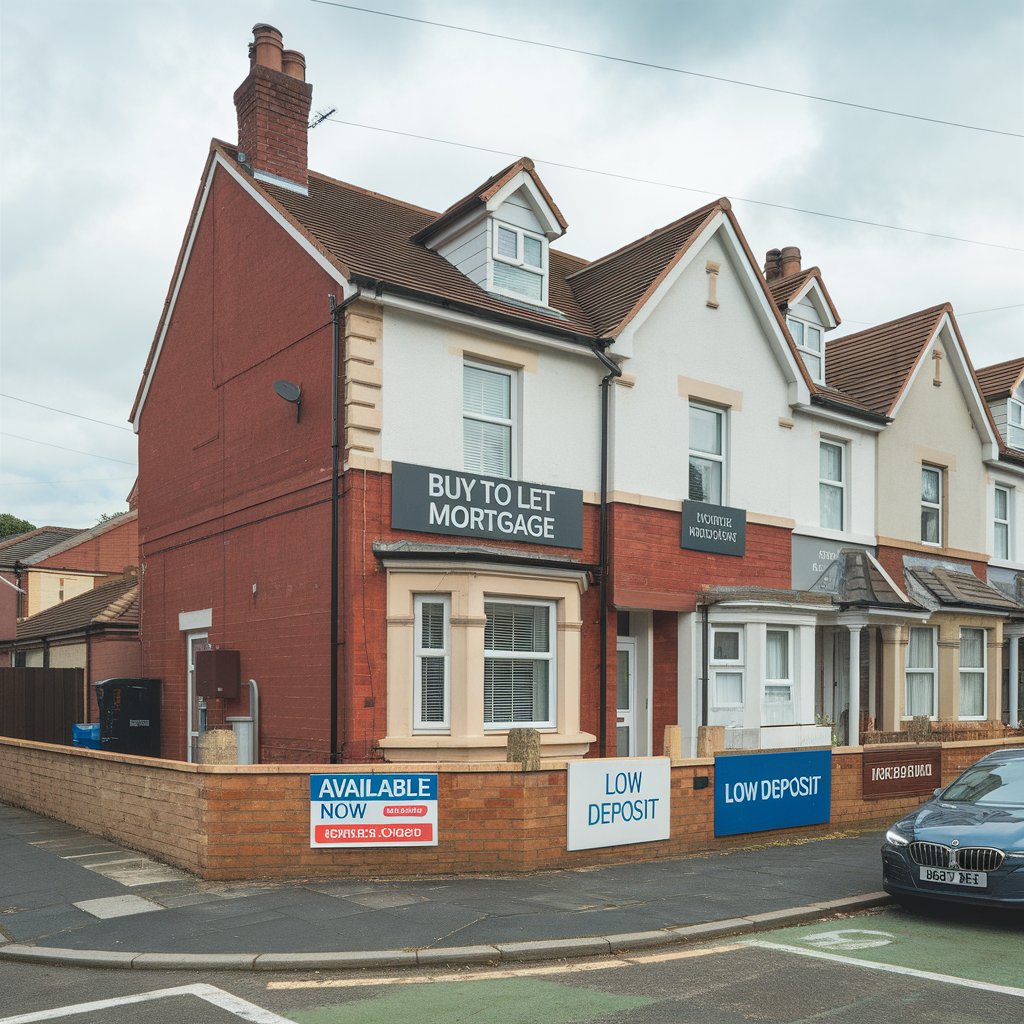Many are uncertain if acquiring a property to rent qualifies one as a first-time buyer – a query often raised by those keen to invest in the property market, seeking a consistent return from rental properties.
This aspiration frequently needs clarification regarding eligibility for first-time buyer benefits in the mortgage sector. The question “does buy-to-let count as first-time buyer?” often comes up in discussions.
We’ve explored this complex landscape ourselves, acknowledging how overwhelming it can appear. Through our detailed analysis, we found that almost 30% of all homes financed with a mortgage last year were procured for investment purposes, including buy-to-let scenarios.
Using this data and our mortgage expertise, we aim to offer transparent advice on understanding buy-to-let mortgages and their role in your property ownership or investment goals. You can anticipate practical tips on confidently addressing these challenges.
Keep reading for potential information that could assist in transforming your property ambitions into reality.
Does a Buy-to-Let Mortgage Count for a First-Time Buyer?
Moving forward with our discussion, we now concentrate on the accessibility of a buy-to-let mortgage for first-time buyers. Often potential investors stepping onto the property market ladder question their status as first-time buyers in relation to a buy-to-let investment.
Indeed, lenders do offer buy-to-let mortgages to first-time buyers, albeit with specific criteria and conditions.
Indeed, first-time buyers are eligible to apply for a buy-to-let mortgage; however, they will need to meet stricter lending conditions compared to those buying residential properties for personal use.
Lenders often scrutinise the potential rental income and the buyer’s ability to service mortgage repayments from this income. Moreover, a considerably large deposit is frequently required, usually around 25% of the property value, and one’s credit history holds significant weight in the application process.
This distinct route provides those new to property ownership the chance to invest in real estate by becoming landlords, progressively accumulating wealth through property investment whilst handling the challenges associated with securing their first mortgage deal in the buy-to-let market.
How Does a Buy-to-Let Mortgage Work?
Buy-to-let mortgages offer a way for investors to purchase rental properties. Lenders base these loans on the potential rental income from the property rather than the borrower’s income.
This means we assess how much you can borrow based on what tenants might pay in rent, ensuring the rental income covers mortgage payments comfortably. Interest rates and deposit requirements are generally higher compared to residential mortgages because lenders view buy-to-let as a higher risk.
Before giving approval, we also look into your credit history and other financial commitments. It’s common for lenders to require that the rental income is 125% of the mortgage repayments, providing a cushion against periods when the property may not be rented out.
Many choose interest-only mortgages for buy-to-let investments, meaning monthly payments cover only interest without reducing the principal amount borrowed. This approach keeps monthly costs down whilst planning to pay off or refinance the loan when it’s due or if property values rise.
Who Can Apply for a Buy-to-Let Mortgage?
Almost anyone can apply for a buy-to-let mortgage if they meet specific criteria. You must typically be at least 18 years old and prove you have the financial stability to cover mortgage payments.
Lenders often look for individuals with a strong credit history and may require that you already own your home or another property, although this isn’t always necessary. For first-time buyers interested in buy-to-let properties, it’s crucial to understand that lenders might impose stricter lending criteria compared to those seeking residential mortgages.
Lenders assess potential borrowers according to their capacity to generate consistent rental income from the property. This means you need to show that the expected rent will comfortably cover your mortgage repayments by a certain percentage, often referred to as the interest cover ratio.
Furthermore, having a sizeable deposit enhances your chances of securing better mortgage deals. The typical deposit for buy-to-let mortgages ranges from 20% to 25% of the property’s value, higher than what is usually required for residential properties.
Therefore, preparing financially before applying ensures we position ourselves favourably in front of lenders offering buy-to-let mortgages.
What is a Buy-to-Let Mortgage, and How Does It Work?
A buy-to-let mortgage allows investors to purchase property that they intend to rent out to tenants. Unlike standard residential mortgages, these loans consider the potential rental yield from the property as a key consideration in the eligibility decision-making process and the amount you can borrow.
This means that for first-time buyers looking to invest in the buy-to-let market, lenders will closely assess how much rent the property could generate compared to monthly mortgage payments.
Successful investment in buy-to-let properties starts with choosing the ideal mortgage product that matches your financial objectives.
This approach differs significantly from how most lenders gauge affordability for a normal residential mortgage, where personal earnings and credit rating play larger roles. Buy-to-let mortgages usually require a bigger deposit than their residential counterparts, often around 25% of the property’s purchase price or more.
Interest rates may also be higher due to perceived additional risks by lenders.
Understanding the Basics of Buy-to-Let Mortgages
Buy-to-let mortgages enable us to invest in property with the intention of renting it out to others. Unlike a standard residential mortgage, where we live in the property ourselves, buy-to-let loans are designed for those looking to become landlords.
This type of investment has grown popular as people seek passive income from rental properties. Lenders assess these mortgages differently, typically requiring a larger deposit and considering potential rental income when deciding on eligibility.
Investing in buy-to-let properties can open doors to generating long-term wealth.
Mortgage lenders often require at least a 25% deposit for buy-to-let mortgages, which is higher than many first-time buyer programmes for residential homes. They compute affordability based on projected rental yield instead of just our salary.
This focus on rent ensures that the property purchase is viable as an investment. With proper market research and advice from mortgage advisers, stepping into the buy-to-let market can be a lucrative move for first-time investors ready to climb onto the property ladder.

How Rental Income Influences a Buy-to-Let Mortgage
Lenders consider rental income crucial when we apply for a buy-to-let mortgage. They usually require that the potential rental income from the property covers at least 125% of the monthly mortgage repayments.
This is to ensure there’s enough buffer to manage periods without tenants, known as void periods, and cover any maintenance costs. So, securing a property in an area with strong rental demand is key to meeting these conditions.
We also need to prove that our investment can withstand interest rate rises. Some lenders test this by applying a ‘stress test’ rate, making sure we can still afford the mortgage if rates increase.
For example, even if we’re offered an interest rate of 2%, they might calculate affordability based on a higher rate of 5%. This approach protects both us and the lender by ensuring that future financial risks are manageable and don’t strain our ability to repay the loan or manage the property efficiently.
The Role of a Mortgage Broker in Buy-to-Let Purchases
We frequently guide clients through the role of a mortgage broker in buy-to-let purchases. A mortgage broker serves as an essential connector between you and potential lenders. They bring extensive knowledge about the buy-to-let market to the situation, ensuring you gain access to appropriate mortgage products that fit your investment goals.
Mortgage brokers assess your financial situation, offer professional advice on how much stamp duty you might pay, and assist in managing your property portfolio effectively.
Our experience illustrates that an informed adviser can profoundly influence your success as a first-time buyer intending to invest in buy-to-let properties. Brokers negotiate better interest rates and also manage paperwork, easing the application process.
They understand lender criteria thoroughly and can align them with your situation, increasing the approval possibilities for first-time landlords aspiring to join the buy-to-let market.
What is a Buy-to-Let Mortgage, and How Does it Differ from a Residential Mortgage?
A buy-to-let mortgage is intended for individuals who wish to invest in property for rental purposes. This is quite different from a residential mortgage, which you obtain when purchasing a home for personal residence.
For buy-to-let mortgages, lenders evaluate the potential rental income from the property rather than solely your salary. Therefore, your capacity to meet mortgage payments is more dependent on the possible monthly earnings.
The primary difference resides in how lenders scrutinise applications and handle risks. For example, they typically necessitate a higher deposit for buy-to-let properties often around 25% of the property’s worth or more.
Plus, the majority of buy-to-let mortgages are interest-only, enabling landlords to settle only the interest each month whilst the borrowed sum is due at the term’s conclusion. This arrangement may be suitable for landlords searching for investment chances but also presents distinct challenges in contrast to obtaining a loan for a residential property where repayments reduce both interest and capital from the outset.
Key Differences Between Buy-to-Let and Residential Mortgages
One significant variation between buy-to-let mortgages and residential mortgages resides in the standards lenders employ to determine your borrowing capacity. For buy-to-let properties, banks primarily focus on the potential rental income instead of your personal income.
This implies they evaluate if the anticipated rent will meet the mortgage repayments by a certain percentage, frequently around 125%-145%. Conversely, for a residential mortgage, lenders determine your borrowing capacity based on your salary and other personal financial commitments.
Another important point is that buy-to-let mortgages are usually interest only, suggesting monthly payments cover just the interest without lessening the principal amount borrowed.
This is different from most residential mortgages, where monthly payments gradually reduce both interest and capital. Moreover, first-time buyers contemplating buy-to-let investments should be prepared for higher deposit requirements – generally at least 25% of the property’s value – in contrast to residential purchases, where deposits could be as low as 5%.
As they progress further, potential investors need to comprehend how these differences impact their purchasing power and investment strategy before immersing themselves in the property market.
Is a Buy-to-Let Mortgage Suitable for a First-Time Buyer?
Transitioning from the contrasts between buy-to-let and residential mortgages, we touch on the suitability of a buy-to-let mortgage for first-time buyers. We frequently encounter individuals keen to venture into rental property as their debut in homeownership. Understanding the differences between the two types of mortgages can help first-time buyers make a more informed decision about which path to pursue.
For many, a buy-to-let mortgage presents this opportunity. These financial instruments are structured for those intending to acquire property with the purpose of renting it out.
First-time buyers contemplating this option must appreciate that lenders perceive these mortgages distinctively from standard residential ones. The emphasis shifts to the potential rental income rather than solely the applicant’s income.
This can be a benefit if your wage on its own might not secure a large enough loan under typical circumstances. Nonetheless, obtaining such investment necessitates meeting particular standards, including having a larger deposit—typically around 25% of the property’s value—and demonstrating that anticipated rent covers mortgage repayments adequately.

What Are the Requirements for First-Time Buyers Seeking Buy-to-Let Mortgages?
First-time buyers looking to secure buy-to-let mortgages face specific requirements that differ from standard residential mortgage applications. Understanding these criteria helps potential investors prepare adequately for their property investment journey.
- Deposit requirements: Most lenders require a minimum deposit of 25% of the property’s value, significantly higher than residential mortgages which can start from 5%.
- Credit score standards: A good credit history is essential, as lenders view buy-to-let investments as higher risk. Poor credit can limit options or result in higher interest rates.
- Rental income calculations: Lenders typically require that projected rental income covers 125%-145% of the monthly mortgage payments to account for void periods and maintenance costs.
- Age limits: Numerous buy-to-let lenders impose an application age limit (typically around 21 years old) and an age limit upon the mortgage term’s conclusion (often up to 70 or 75 years old).
- Income requirements: Some lenders require you to earn above a certain threshold, typically around £25,000 per year, not including any potential rental income.
- Property type: The variety of property you aim to buy impacts the mortgage deal you receive. Some lenders impose restrictions on loans for flats situated above commercial buildings or non-standard construction residences.
- Ownership status: If you plan to purchase within a limited company structure, different standards apply in comparison to individual ownership regarding tax efficiency and loan terms.
- Stamp duty considerations: Often, first-time buyers gain from stamp duty exemption on their main residence but will encounter higher rates when acquiring additional properties, including buy-to-lets.
By contemplating these components, we efficiently lead our clients through their expedition into the buy-to-let market, particularly those initially stepping onto the property ladder. We supply comprehensive advice on understanding these prerequisites and optimising investment opportunities within the property sector.
How to Get a Buy-to-Let Mortgage as a New Buyer
Securing a buy-to-let mortgage as a new buyer is a complex process. We aim to simplify it with clear steps and essential advice.
- Check your eligibility: Understand the lender’s criteria for first-time buyer buy-to-let mortgages. Generally, you need a good credit score and stable income.
- Save for a deposit: You typically need at least a 25% deposit for buy-to-let properties, higher than for residential ones.
- Understand rental income requirements: Lenders require that the rental income is 125%-145% of the mortgage repayments to ensure you can cover costs.
- Get your financial documents in order: Prepare evidence of income, bank statements, and any additional documents lenders might need.
- Consider using a mortgage broker: They specialise in buy-to-let properties and can guide you through the application process.
- Look at different buy-to-let mortgages: Interest rates and terms vary, so explore multiple options to find the best deal.
- Factor in associated costs: Budget for stamp duty, legal fees, and potential renovations on top of your deposit and monthly repayments.
- Think about long-term financial planning: Ensure this investment fits with your future financial goals, including considerations around capital gains tax and rental yield.
- Apply for pre-approval: This shows estate agents and sellers that you are a serious buyer with financing in place.
- Start property hunting: Look for properties that offer high rental yield potential within your budget range.
- Make an offer on a property: Once accepted, proceed with the formal mortgage application process.
By following these steps closely, new buyers can navigate their way to securing a buy-to-let mortgage efficiently whilst minimising potential hurdles along the way.
What Are the Risks and Benefits of a Buy-to-Let Investment?
Investing in a buy-to-let property can offer significant advantages for those making their landlord debut. A major plus point is the potential for steady rental income, which can offset mortgage repayments and provide surplus cash flow.
Buy-to-let properties also present the possibility of growing in value over time, enabling landlords to have a shot at capital growth upon deciding to sell. Moreover, becoming a landlord allows you to step onto the property ladder and initiate your portfolio.
Yet, these investments carry certain risks. Market conditions can shift, affecting property values and demand for rentals. Those just starting as landlords need to ensure effective management of their properties to avoid potential vacancies and income loss.
The interaction with tenants is another aspect that may not always progress without hitches. Understanding the stamp duty on buy-to-let properties is vital as it imposes initial costs that could impact your budget planning.
Turning our attention to how lenders grant buy-to-let mortgages to first-time buyers highlights another important element of entering this market.
Potential Risks of Buy-to-Let Investments
Exploring the buy-to-let market can stir up excitement, particularly for those entering for the first time. Yet, it’s crucial to reflect on the potential risks tied to these investments.
- Unpredictable Property Values: The property market can be unstable. Prices can drop, affecting the value of your investment.
- Rental Void Periods: There will inevitably be periods where your property remains vacant between tenants, resulting in a loss of rental income.
- Unforeseen Maintenance Costs: Being a property owner entails the duty of maintaining the property. Unexpected repairs can greatly affect your earnings.
- Changes in Mortgage Interest Rates: If your mortgage rate is variable, the interest rates could surge and raise your monthly instalments.
- Stricter Lending Criteria: Financial institutions usually hold tighter criteria for buy-to-let mortgages, which might influence your eligibility.
- Tax Implications: Tax regulations associated with buy-to-let properties are intricate and changeable. Income tax on rent and fluctuations in stamp duty can impact your profits.
- Problematic Tenants: Troublesome tenants can cause a variety of problems, ranging from unpaid rent to property damage.
- Regulation Changes: The buy-to-let sector is prone to regulatory adjustments that might affect how you operate your property or your overall earnings.
- High Entry Costs: Initial payments for buy-to-let mortgages are often more than those for residential mortgages, which means a heftier initial expense.
- Difficulty Selling: If there is a need for a quick sale, market conditions might not be in your favour, affecting your ability to sell the property at the desired price.
Weighing these risks before investing in buy-to-let properties will guide you in making enlightened decisions as you step into the housing market as a first-time buyer or landlord.

Benefits of Starting as a First-Time Landlord
Embarking on the buy-to-let market as new landlords can lead to considerable financial benefits. One of the main perks is the generation of a constant flow of rental income. This supplementary cash flow can aid in covering mortgage repayments, upkeep costs, and possibly provide extra income.
Investing in buy-to-let properties further presents the possibility for capital growth over time, as property values typically rise, offering landlords a chance for long-term financial gain.
As new landlords, we possess a distinctive opportunity to mould our portfolios from scratch, making strategic decisions that start our journey to financial security.
Furthermore, becoming a landlord permits individuals to broaden their investment portfolio beyond conventional stocks and shares. Property is often deemed a rather stable asset compared to unpredictable stock markets, offering a real investment that can be managed directly.
With comprehensive research and management, new buyer landlords can relish more than monthly rental yields but also long-term asset growth—making it an appealing proposition for those venturing into real estate investment for the first time.
Long-Term Financial Planning with Buy-to-Let Properties
After exploring the advantages of becoming a new landlord, it’s essential to concentrate on long-term financial planning with buy-to-let properties. Planning for the future requires more than just grasping the initial benefits.
A strategic method ensures that your investment expands over time and continues to meet your financial targets.
Buy-to-let properties can serve as a consistent income source if managed prudently. This necessitates judicious property selection, comprehension of market trends, and awareness of when it could be favourable to sell or enhance your portfolio.
We counsel clients to contemplate how fluctuations in mortgage rates and property values could influence their investment. With strategic long-term planning, purchasing to let offers a potential route for achieving improved financial stability and amassing wealth over time.

Conclusion
We comprehend the challenges newcomers face when they step into the buy-to-let market for the first time. It’s a courageous move for enduring financial stability. Our team is ready to lead you through each phase, from decoding the eligibility criteria to efficient property management.
We aim to facilitate your transition, confirming you meet lender prerequisites and achieve advantageous mortgage terms.
Acquiring a buy-to-let mortgage can be a viable path for new investors eager to establish themselves on the property ladder. Utilising our expertise, we’ll assist you in interpreting the details of deposits, rental income predictions, and stamp duty considerations.
Collaborating with professional mortgage advisers translates to making confident progress towards evolving as successful first-time landlords, ready to flourish in the buy-to-let market.
This information is for guidance only and does not constitute financial advice. Always seek professional advice from FCA authorised advisers before making any buy-to-let investment decisions. If you have a complaint about mortgage advice, you can contact the Financial Ombudsman Service free of charge.




